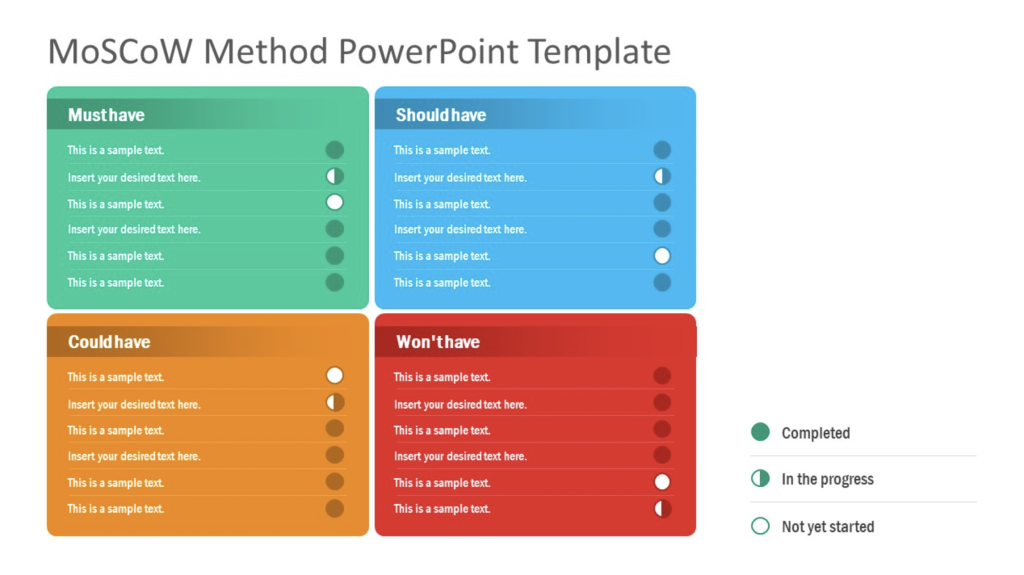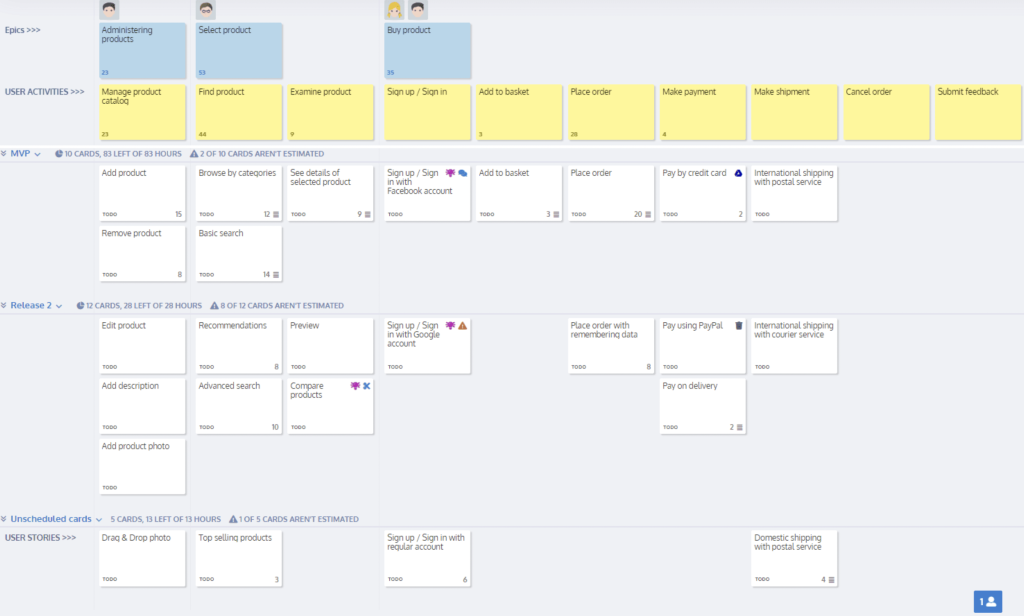
To keep a project in order
Imagine a project with hundreds of tasks in its backlog. An average team of 10 developers won’t be able to cover everything at the same time. Therefore, to create a minimum viable product, you have to group tasks by importance and urgency. The Pareto principle applies to flexible projects and operates according to the following logic: 80% of the product cost falls on 20% of the elements of undone project work. How can you single out these “magic” 20%? Let’s take a look at five powerful methods for project prioritization.
What is project prioritization?
By prioritizing, a person evaluates the volume of tasks and distributes them by importance and urgency according to the “do the most important things first” rule. We don’t pay much attention to it but people make choices all the time when they decide whether to go to the store first, have lunch with a friend, or visit a doctor.
In cases with Agile product development, ranking tasks is a little more difficult because they need to be prioritized according to certain criteria. This process is quite difficult for the human brain. But special methods come to the rescue, with which it becomes easier to plan work.
The problem of setting priorities
Prioritization is an important part of Agile software development. Team members generally know what they have to do but their plan is concretized by smaller tasks. The functionality important for users is implemented in the first place and meets certain criteria. These can be:
- value for users;
- urgency;
- time frame;
- technical complexity;
- customer’s preference.
Companies that provide project management services address the issue of prioritization at two levels:
- product level (functions that will help achieve the main goals of the project);
- the level of tasks (user stories, the execution of which implements these functions).
Five common prioritization methods
You should not allow the product backlog to turn into a collection of random thoughts. In any case, there must be order and logic. This makes it easier to track employee performance and compliance with the plan. The following prioritization techniques help organize the work of an Agile team effectively.
$100 test
There is a simple and clear task ranking method behind this symbolic name. Project participants gather to prioritize their work. They are asked to evaluate a list of backlogs for a product.
All team members receive the same amount of money – $100 (it can also be the same number of points). With their help, specialists can vote for user stories, assigning them a certain number of dollars or points. For example, a team member might decide that “Login with a username and password” is more important than “Login with FaceID” and assign 40 points to the first task and 20 points to the second one. Each voter distributes their 100 points. In practice, it might look something like this:
Infographic 1: https://www.tillerhq.com/wp-content/uploads/2019/03/Vote-With-Your-Dollars.png
After voting, the sum of points for each project task is calculated. This method is often called the fixed sum method. Brainstorm participants are given a set of tasks to which they need to allocate 100 points, considering their importance relative to each other.
The team is looking for a compromise. Thus, they determine which tasks should be solved in the first place, and which ones should be ranked in descending order. The distribution also takes into account the experience of specialists. Experienced developers don’t have a single project under their belt, and they clearly understand what should be done first and what can be postponed.
Priority poker
Priority poker is not just a card game. It is similar to planning poker but has a different purpose – to rank user stories by importance and urgency.
Just like in the $100 test, the moderator needs stakeholders to queue tasks. Usually, these are product owners, designers, programmers, testers, and other employees involved in the project. The poker organizer is the PM, who is responsible for prioritizing and timely completion of project tasks. But we will talk about this a little later.
The moderator offers the participants a list of tasks and a set of priority cards for each player. Depending on the priority scale, such a set includes 3, 5, or 10 cards. For example, 5 criteria by importance: very high priority, high priority, medium priority, low priority, and very low priority. Or 3 criteria for urgency: high urgency, medium urgency, and low urgency.
Infographic 2: https://www.uxforthemasses.com/wp-content/uploads/2010/12/Priority-cards.png
The poker host then reads a user story. Each participant lays a card corresponding to the task out on the table, face down. Then all the cards are opened and the differences in choice are discussed. The game ends when the scores are about the same.
This prioritization method is very convenient and fast, and it is carried out in large groups (5 people and more). With poker, you can rank product requirements, testing tasks, and bugs. It is used throughout the project because of its simplicity.
The MoSCoW analysis
The MoSCoW analysis is a common method among Project Managers and Business Analysts. The consonants in this word – MSCW – indicate the degrees of priority:
M – must have.
A critical task to close a release successfully. For example, “Create a personal user account”, “Create a product catalog”, “Enable the ability to add products to the cart”, and so on.
S – should have.
A mandatory task but with a lower priority. For example, “Introduce a time tracker”, “Integrate platforms with Slack to receive updates on boards”, and so on.
C – could have.
A desirable but optional task. It may be included in a sprint if time and resources permit. When both are missing, the task will be moved to the next release. For example, “Add the ability to pay for goods through Apple Pay”, “Add a history of purchased goods”, and so on.
W – would have.
A task of low priority, which can be postponed for not one but several later releases. For example, “Add a calendar to the site”, “Add a time counter” and so on.

After the tasks are divided into groups, they are ranked within each category. Despite the simplicity and clarity, such a classification is not always enough. Therefore, MoSCoW is better suited for small or internal projects.
The Kano model
The technique of prioritizing project tasks created by the Japanese Noriaki Kano is also relevant. However, it focuses primarily on the impression and satisfaction of users.
Instead of cards and scores, the model uses a coordinate system. The Y-axis illustrates customer satisfaction and the X-axis represents the level of completion.
Infographic 4: https://miro.medium.com/max/1118/1*_MnpPIQ7p3wGCddgnPP_dw.png
The Kano model singles out the quality criteria that affect users:
- expected features;
- key features;
- impressive features.
Expected features are the basic qualities of a product implemented by default in this kind of project. That is, a catalog of an online store must have search filtering. A person rarely thinks about such features because this is standard practice for eCommerce sites. Let’s compare it to the operation of an airline. The guarantee that all passengers have enough seats is an expected feature.
Key features directly affect customer satisfaction. By developing them, companies seek to stand out and outperform their competitors. For example, they can add additional methods to the form of payment for goods: cash on delivery, cash to the courier, card to the courier, or online bank card. Thus, they will attract more customers than their competitors that only have a couple of payment methods available. In the airline example, the key feature might be the absence of transfers.
Impressive features are features unexpected for a consumer. For example, the ability to pay for goods by credit card, electronic money, or PayPal. A favorite dish on board is also an example of an impressive feature. If there are no such properties in a program, users won’t be upset. But if you include them, your clients will be delighted and will share a positive experience with their friends. Good advertising will work for the benefit of your business.
User Story Mapping technique
The USM method is used when it is necessary to visualize all design tasks by user steps, from the beginning of interaction with the product discovery process to the end, and then move them to the backlog.
All tasks are located in two dimensions. The vertical one indicates the priority, while the horizontal one indicates the user’s step-by-step path. In practice, it looks like a block table.

Horizontal blocks represent large custom steps – epics. In turn, they are divided into smaller tasks. For example, if “Product Search” is an epic, then user stories could be “Basic Search”, “Advanced Search”, “Search by Product Filtering”, and so on. Thus, the most important tasks are located in the upper left corner.
With the help of a map, it is easier for the project team to discuss questions such as “Why is this story needed?”, “Why are these stories more important than others?” It is easier for specialists to find user stories, and technical tasks and move them to the backlog without missing important functionality. Everything you need to create an MVP is at hand.
Advantages and disadvantages of prioritization methods
The above methods help to effectively rank tasks, taking into account the expert opinion of developers. But there is one weak point. For prioritization to be successful, the entire team must know the project well. If there are too many tasks in the backlog and the participants have a superficial knowledge of the project, the ranking will be delayed. Evaluation of tasks will be approximate, which is useless work.
Therefore, a project needs someone who will process a huge amount of information about the product and be responsible for prioritization. This is a Project Manager.
PM as a prioritization master
Any project is limited in time, scope, and cost. This balance is set by the customer and is entrusted to the Project Manager. It is difficult for the team to imagine the overall situation of the project since each of its members is used to doing only their part of the work. For the clock mechanism to work, every detail of it must function smoothly and accurately. The Project Manager becomes a kind of “winder”.
To streamline project work, the PM plans, organizes, and controls it. Prioritization is part of planning, which largely determines the success of a sprint, a release, and the entire project as a whole. Proper ranking saves developers time and resources.
Successful planning helps the team to do their job comfortably and gives the customer confidence that critical tasks will be done by the release. Order, organization, and efficiency are the qualities that define a good workflow on a project.
Conclusion
Task prioritization makes the product management discovery more predictable. The team understands what tasks they need to do and the deadline. This approach helps avoid situations where you have to work day and night to meet deadlines. A task solved timely and correctly saves the budget and pleases the customer.
Project managers know the best practices for prioritizing, planning, and tracking product work. Through the thoughtful organization, they can achieve 25% budget savings through risk avoidance and 20% faster product delivery to production.


